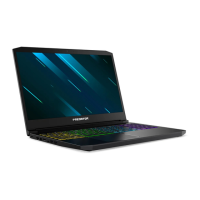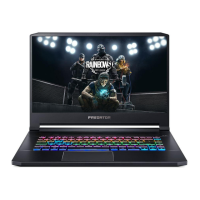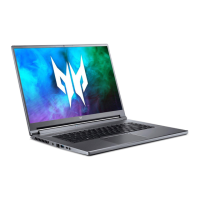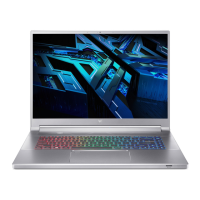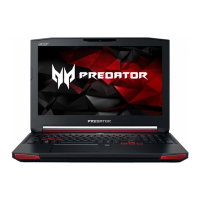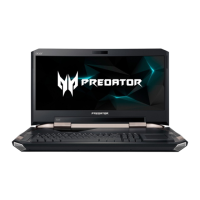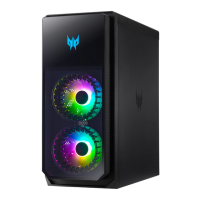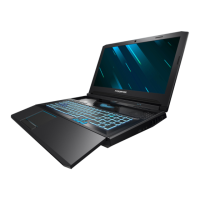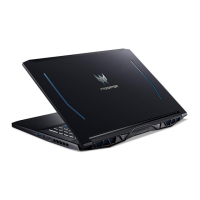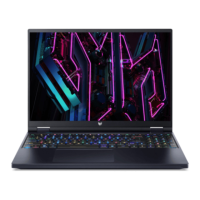Do you have a question about the Acer PREDATOR TRITON 900 and is the answer not in the manual?
Explains the available guides for using the notebook.
Provides essential advice for maintaining the computer's condition and longevity.
Guides the user through the different parts and features of the notebook.
Explains the function of Caps Lock and Scroll Lock keys.
Details keyboard shortcuts (Fn key combinations) for various functions.
Describes keys with Windows-specific functions.
Explains various multi-finger gestures for touchpad navigation.
Steps to adjust touchpad sensitivity and other preferences.
Guides on creating a backup of the system and installed applications.
Instructions for backing up network drivers for reinstallation.
Steps to reset or restore the PC to its original state.
How to turn the computer's Bluetooth adapter on and off.
Steps for pairing and connecting Bluetooth devices.
How to connect to available wireless networks like Wi-Fi.
Instructions for establishing an internet connection using an Ethernet cable.
Steps to connect to the internet using a cellular data connection.
Overview of the PredatorSense application interface and its main functions.
How to adjust system settings and audio modes within PredatorSense.
Customizing keyboard lighting effects and colors.
Managing fan speeds and cooling performance for CPU and GPU.
Checking processor, GPU, and system temperatures and loading.
Managing and launching installed applications through the App Center.
Adjusting settings to reduce blue light emissions from the screen.
How to physically secure the computer using a lock.
Setting up passwords for BIOS, boot, and user access.
Procedures for entering passwords when prompted.
Configuring the order in which the computer boots from devices.
How to set Supervisor and Password on Boot options in BIOS.
Tips and settings to reduce power consumption and extend battery life.
Information about the embedded Lithium battery.
Procedures for charging the laptop's battery.
Steps for preparing a new battery for optimal performance.
Methods to maximize battery operational time and lifespan.
How to view the current battery charge status.
Actions to take when the battery charge is low.
Steps to safely disconnect external devices before moving.
Advice for short-distance movements within a location.
How to prepare the laptop for travel, including sleep mode and shutdown.
Essential items to carry when traveling with the computer.
Advice on protecting the computer from temperature and humidity changes.
Specific advice for international travel, including battery regulations.
Details about the USB Type-C connector and its capabilities.
Information on the Thunderbolt 3 port and its high-speed data transfer.
Steps to connect an external display device to the computer.
How to connect audio devices and microphones.
Addresses frequent problems like boot failures, blank screens, and audio/keyboard issues.
Guidance on resetting the PC to its original settings.
Information on obtaining technical support and warranty service.
Details to prepare before calling customer support for assistance.
Guides on accessing Start, turning off the PC, and unlocking.
Customizing lock screens, tiles, and other display settings.
Explains features like setting alarms and using Microsoft accounts.
Steps to check for and install Windows operating system updates.
General advice for diagnosing and resolving system problems.
Lists common error messages and their corrective actions.
Essential steps to secure the computer against online threats.
Overview of different methods to connect to the internet (DSL, Cable, Cellular).
Information on setting up wired (LAN) and wireless networks.
Tactics and advice to prevent cyber threats and protect data.
Defines viruses and malware and how to deal with infections.
Security measures for using unsecured public Wi-Fi networks.
Utilizing Windows features like updates for security.
| Processor code | SR3YY |
|---|---|
| Processor ARK ID | 134906 |
| Processor package size | 42 x 28 mm |
| CPU configuration (max) | 1 |
| Supported instruction sets | AVX 2.0, SSE4.1, SSE4.2 |
| Intel Trusted Execution Technology | No |
| Intel Identity Protection Technology version | 1.00 |
| Intel Stable Image Platform Program (SIPP) version | 0.00 |
| Bus type | DMI |
| Stepping | U0 |
| Tjunction | 100 °C |
| Processor cache | 9 MB |
| Processor cores | 6 |
| System bus rate | 8 GT/s |
| Processor family | Intel® Core™ i7 |
| Processor socket | BGA 1440 |
| Processor threads | 12 |
| Processor codename | Coffee Lake |
| Processor frequency | 2.2 GHz |
| Processor cache type | Smart Cache |
| Configurable TDP-down | 35 W |
| Processor lithography | 14 nm |
| Processor manufacturer | Intel |
| PCI Express slots version | 3.0 |
| Processor boost frequency | 4.1 GHz |
| Processor operating modes | 64-bit |
| PCI Express configurations | 1x16, 1x8+2x4, 2x8 |
| Thermal Design Power (TDP) | 45 W |
| Configurable TDP-down frequency | 1.7 GHz |
| Maximum number of PCI Express lanes | 16 |
| On-board graphics card ID | 0x3E9B |
| Discrete graphics card model | NVIDIA® GeForce RTX™ 2080 |
| On-board graphics card model | Intel® UHD Graphics 630 |
| Discrete graphics card memory | 8 GB |
| Discrete graphics memory type | GDDR6 |
| On-board graphics card family | Intel® UHD Graphics |
| Maximum on-board graphics card memory | 64 GB |
| On-board graphics card OpenGL version | 4.5 |
| On-board graphics card base frequency | 350 MHz |
| On-board graphics card DirectX version | 12.0 |
| On-board graphics card dynamic frequency (max) | 1100 MHz |
| Memory slots | 2x SO-DIMM |
| Internal memory | 32 GB |
| Memory form factor | SO-DIMM |
| Internal memory type | DDR4-SDRAM |
| SSD capacity | 512 GB |
| Storage media | SSD |
| Total storage capacity | 1024 GB |
| Number of SSDs installed | 2 |
| Form factor | Convertible (Ferris Wheel) |
| Product type | Hybrid (2-in-1) |
| Product color | Black |
| Market positioning | Gaming |
| Display diagonal | 17.3 \ |
| Touch technology | Multi-touch |
| Native aspect ratio | 16:9 |
| Battery capacity | 4670 mAh |
| Battery life (max) | 3 h |
| Number of battery cells | 4 |
| AC adapter power | 330 W |
| Antenna type | 2x2 |
| Wi-Fi standards | 802.11a, 802.11b, 802.11g, Wi-Fi 4 (802.11n), Wi-Fi 5 (802.11ac) |
| Bluetooth version | 5.0 |
| Top Wi-Fi standard | Wi-Fi 5 (802.11ac) |
| WLAN controller model | Killer Wireless-AC 1550i |
| Ethernet LAN data rates | 10, 100, 1000 Mbit/s |
| Charging port type | DC-in jack |
| USB 2.0 ports quantity | USB 2.0 ports have a data transmission speed of 480 Mbps, and are backwards compatible with USB 1.1 ports. You can connect all kinds of peripheral devices to them. |
| Thunderbolt 3 ports quantity | - |
| USB 3.2 Gen 1 (3.1 Gen 1) Type-C ports quantity | 0 |
| Pointing device | Touchpad |
| Keyboard language | Nordic |
| Depth | 303.3 mm |
|---|---|
| Width | 428 mm |
| Height | 23.8 mm |
| Weight | 4500 g |
